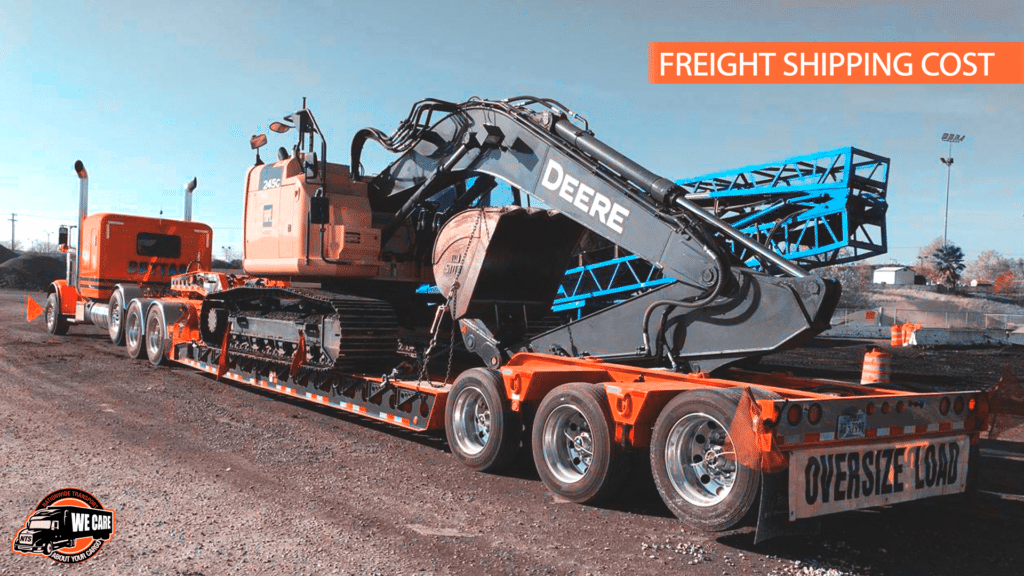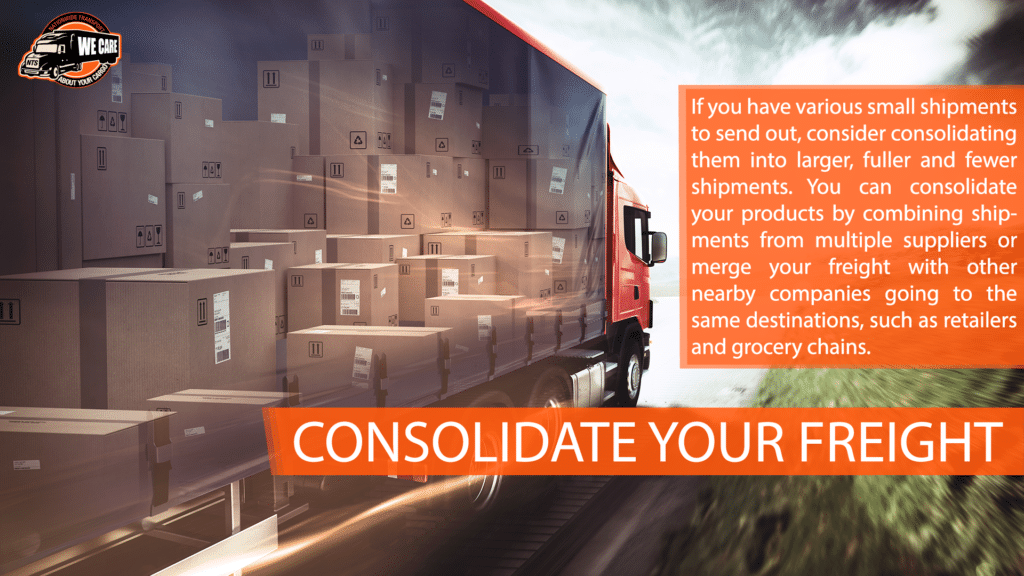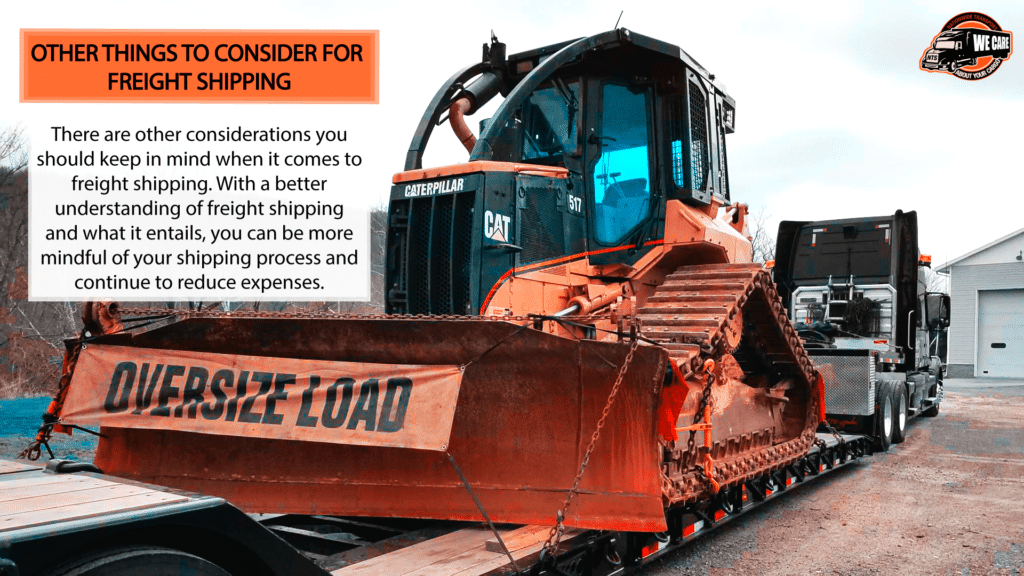
- How Much Does Freight Shipping Cost?
- 11 Ways to Reduce Your Freight Shipping Costs
- Other Things to Consider for Freight Shipping
- Get a Quote on Freight Shipping Costs Today
Freight shipping is the bulk transportation of any goods, cargo and commodities weighing over 150 pounds, either by truck, train, aircraft or ship. In 2017, companies spent a record $1.5 trillion on shipping, a rate 6.2% higher than the previous year. The next year, logistics freight costs rose by 11.4% to a total of $1.64 trillion. With shipping costs on the rise with no indications of slowing down, it can be challenging for businesses to keep up.
Your company doesn’t have to fall victim to increased freight costs. Fortunately, there are many simple ways to reduce shipping costs for your business. Through this comprehensive guide, we’ll explain how freight shipping costs are determined and highlight various tips for keeping shipping costs low.

How Much Does Freight Shipping Cost?
There’s no one rate for how much freight shipping costs. These expenses depend on numerous factors, most of which are based on the characteristics of the items you’re planning to ship. With so many factors at play, there’s no average cost of freight shipping that works as a general rule to estimate shipments. Large freight shipping costs play by different rules from smaller freight, as do different shipping methods. Freight shipping can range anywhere from tens to hundreds to thousands of dollars, depending on how the details add up.
You can better determine how expensive your freight shipping will be by knowing the factors that impact your rates.
Weight
Perhaps the most obvious aspect of shipping cost determination is how much the shipment weighs. Naturally, you would assume that heavier items cost more to ship than lighter-weight ones — however, this statement is generally false. In the case of less-than-truckload (LTL) shipping, the heavier your freight is, the less it will cost for every hundred pounds being shipped. That means you usually get a much better deal shipping larger loads than smaller ones.
Density
Shipments that weigh exactly the same usually won’t cost the same amount to ship due to differing densities. Freight density is an item’s weight versus dimensions and is determined by dividing weight by the volume or total cubic feet.
Density has a significant impact on what freight class a shipment falls into. Materials with low densities fall into higher freight classes. The higher the freight class, the more expensive the shipping becomes. That means the denser the cargo, the less you’ll have to pay to ship it. That’s because denser freight takes up less space on a truck, plane or ship than goods of a lesser density.
For example, if you shipped 100 pounds of metal and 100 pounds of ping pong balls, the ping pong balls would cost more to ship because they’re not nearly as dense.
Dimensions
Your freight’s dimensions have a bearing on its shipping costs. Items that can be disassembled into smaller, flatter pieces are easier to transport than assembled objects because they take up less space. That’s why broken-down freight is typically less expensive to ship than fully erected products.
So, if you were to ship a bookshelf, you would likely experience a price reduction if you deconstructed it first.
Stowability
Some objects will cost more than others because they pose stowing challenges. Stowability is how well an item fits into a container during transport based on its dimensions, or size and shape. In terms of shipping, stowability refers to how easily freight can be loaded, stacked and stored on a truck.
Freight that stores well will cost less to ship than products that don’t. Some examples of why a load might be more expensive due to stowability issues include bulkiness, no stacking ability, awkward shape, long length or lack of load-bearing surfaces.
Handling
Some freight has special handling needs, which require extra care, labor and tools to safely transport, resulting in higher expenses. Special handling may be necessary for items that are cumbersome, hazardous, oddly shaped or fragile. These characteristics warrant additional measures to prevent complications, with prices reflecting these extra efforts.
Accessorials
Accessorials are services that are requested or necessary due to special shipping circumstances. Because these services go beyond a carrier’s standard pickup and delivery duties and are not required of the carrier, they may charge extra for them.
Examples of accessorial services include:
- Limited access location delivery
- Inside delivery
- Long haul shipping
- Residential pickup or delivery
- Palletizing
- Gate services
- Saturday delivery
- Fuel surcharge
Mode of Transportation and Delivery Time
Freight can be shipped by plane, train, truck or ship. Each of these shipping methods comes with different freight costs. The mode of transportation assigned to each item depends on the type of shipment and its intended delivery time.
For example, freight shipping by airplane is one of the fastest shipping options, so it tends to be more expensive. On the other hand, you might ship by train if you don’t have any tight deadlines to adhere to since train shipping is considerably less expensive.
Freight Class
An object’s freight class is based on the National Motor Freight Classification (NMFC) standard. The NMFC compares commodities moving in intrastate, interstate and foreign commerce by grouping them into 18 freight classes ranging from class 50 to class 500. The higher the freight class, the more expensive the shipping.
The NMFC standard evaluates four different characteristics to determine an item’s freight class — density, stowability, handling and liability — all of which create a measure of a commodity’s transportability.
11 Ways to Reduce Your Freight Shipping Costs
Freight shipping can be expensive. Shipping expenses account for a large portion of your company’s budget. Many businesses accept these charges as fixed costs that cannot be altered, giving up the chance of potential savings. Contrary to this belief, there are many simple ways you can reduce your logistics freight costs. Implementing these tactics into your company’s freight shipping procedures can save your organization money.
You can learn how to keep shipping costs low with the following freight cost reduction ideas.

1. Consolidate Your Freight
If you have various small shipments to send out, consider consolidating them into larger, fuller and fewer shipments. You can consolidate your products by combining shipments from multiple suppliers or merge your freight with other nearby companies going to the same destinations, such as retailers and grocery chains.
Your company saves money, and so do the other businesses involved, each supplier only paying for their share of the altogether less-expensive shipment. In addition, retailers receive their shipments on time with the same volume of goods in fewer, fuller loads.
2. Reduce Shipping Frequency
Shipping small loads with great frequency can add up for your company. For instance, it’s more expensive to ship two pallets every two days than to send six all at once.
You can cut down these costs by encouraging your customers to buy products in larger orders rather than ordering smaller shipments across a shorter timeframe. You may have to incentivize bulk ordering to convince your customers to purchase more freight than they need, such as discounts or free shipping over a certain dollar amount.
3. Ship on Off-Peak Days
The day and time you decide to ship freight have a considerable impact on your freight shipping costs. Typically, shipping goods on a customer’s low-traffic days costs less than sending them on their peak days. Many companies like receiving shipments on Thursday so they can shelve products by Friday and be ready for heavy weekend traffic. Monday is a low-volume day that you could consider when choosing an off-peak day to ship out freight.
4. Determine the Best Mode of Transportation
It’s a good rule of thumb to evaluate your transportation options before shipping out freight. Each mode of transportation has varying prices, some being much more expensive than others.
Because air transportation is the most expensive means of shipping goods, planes are typically only used for transporting shipments with arrival deadlines or smaller items of relatively high value. Railways are ideal for shipping bulk products and localized freight. Usually, rail shipping costs less than truck transportation. Sea transport is the slowest and least expensive mode of shipping.
5. Decrease Dunnage
Many shipments require dunnage to keep freight secure and protected from breakage, using materials like bubble wrap, air pillows, kraft paper, bracing and strapping. Though dunnage is necessary for safeguarding items from damage, some shippers overcompensate by purchasing more than they actually need, resulting in higher shipping costs.
Try assessing your dunnage usage to determine if it’s practical or could be reduced without increasing the risk of product damage.
6. Establish Yourself as a Fast Loader
Carriers typically base their pricing around an estimated two-hour loading window. However, if a company establishes itself as a fast loader who can complete loading tasks in half the time, carriers will likely account for that time difference in their price.
If your loading performance is consistent enough, you might even get a reduction built into your rate. As an efficient loader, you’ll save money for your company while attracting more carriers who wish to serve you.
7. Use Load Boards
You can use load boards to reduce freight shipping costs for your business. Load boards are online marketplaces where freight brokers and shippers can locate carriers to ship their loads, enabling these carriers to keep their trucks full.
When you put smaller shipments on a load board, carriers will likely pick it up as backhaul, giving you a lower rate. Backhaul is a commercial truck’s return trip from transporting freight from its current destination to its point of origin.
Because carriers are typically only booked to deliver goods one way, their trucks run on empty miles during the return trip, costing them money. Carriers often use load boards to make up for these losses and find opportunities to deliver goods from their destination back to the point of origin and will offer lower rates to do so. Some carriers are even willing to provide a rate that covers little more than fuel costs.
8. Offer Nighttime Pickups
Another way you can get the chance to make your load into a backhaul is by offering pickup times later in the evening after other shippers have already wrapped up business for the night. While a carrier can easily reject a mid-afternoon pickup request that conflicts with another run, later pickups ensure that these rejections don’t occur. Instead, the carrier can happily fill their backhaul with your freight, reducing your shipping costs.
9. Choose Carriers by Location
If you approach carriers located near your ship-to points, they’ll most likely turn your load into a backhaul. Because the carrier can fill empty miles on their return trip with your freight shipment, they can afford to give you a lower rate. All you have to do is put in the effort to pinpoint a carrier near your shipment’s intended point of origin.
10. Develop Carrier Relationships
Though many companies search for the best deals when choosing freight carriers, this practice isn’t necessarily the best way to save money. Instead of jumping from carrier to carrier in an attempt to reduce freight costs, it often pays to remain loyal to your carriers by developing and maintaining long-term relationships with them.
Long-term contracts give carriers more time to determine the most efficient shipping networks for their customers, maximizing their assets and ultimately becoming more profitable. Successful carriers can afford to give shippers more affordable rates. Plus, long-term contracts lock in a specific rate for the length of the contract instead of changing year by year, giving you more predictable rates and preventing price increases.
11. Work With a Logistics Expert
The best way to reduce freight shipping costs for your company is to hire a logistics transport expert to minimize costs and maximize productivity. Logistics specialists handle a business’s logistics operations involving freight transportation, delivery and storage. These companies coordinate how to get products from point A to point B with maximum efficiency, taking over the planning, implementation and control, so you don’t have to.
Logistics management enables organizations to reduce overhead by cutting freight costs, obtaining the best possible shipping prices and choosing truck drivers based on their transportation needs. Logistics companies will help you ship anything from cars to refrigerated products to lawnmowers to general goods, whether by land or sea, while creating customized freight transport solutions to meet your needs.

Other Things to Consider for Freight Shipping
There are other considerations you should keep in mind when it comes to freight shipping. With a better understanding of freight shipping and what it entails, you can be more mindful of your shipping process and continue to reduce expenses.
Pros and Cons of Each Freight Service
Shipping by road or railway is most cost-effective for moving large shipments across short distances. Ground freight is also widely available to shippers with many carrier choices and trucks working around the clock. However, while trucks and trains produce fewer carbon emissions than ships and planes, they also have weight and volume limits and can be impacted by road and weather conditions.
Ships aren’t impeded by weight, meaning ocean freight has no weight limits. They’re also versatile in the counties they can travel to and the types of items they can ship. They are also more environmentally friendly than planes. The downside to ocean shipping is that it takes much longer than other methods.
Air freight comes with many benefits, such as better cargo protection, real-time tracking capabilities, wider destination reach, fewer packaging requirements and fewer damage risks. Because planes can achieve such rapid delivery, they allow businesses to offer just-in-time (JIT) shipping to meet customer demand faster. However, airplanes have weight and volume limitations and charge higher rates for shipping items that are large or abnormally shaped.
Freight Shipping Methods
In addition to your mode of transportation, there are also numerous shipping methods you should consider for your company:
- Ground freight: Freight carried by truck is typically measured by how much space it accumulates inside a trailer. There are several ground freight methods, including less-than-truckload, full truckload, partial truckload and flatbed shipping.
- Ocean freight: Through this method, items are stored in ISO containers. You can either use a full container or a less-than-container load, depending on your needs.
- Intermodal: The freight is transported on a series of trucks, trains and cargo ships and stored in an intermodal container. The shipment is signed under a single bill and doesn’t require direct handling.
- Multimodal: Multimodal shipping also uses various modes of transportation to carry freight. However, the shipper must interact with each carrier individually.
- Expedited: Used for time-sensitive shipments, this method uses a truck sized specifically for your freight, making few or zero stops to ensure the fastest delivery. Planes usually expedite cargo for overseas shipping.
Get a Quote on Freight Shipping Costs Today
You can receive freight shipping tips to reduce your logistics freight costs from the experienced professionals at Nationwide Transport Services. Our industry-leading logistics company has been in business since 2009, expertly handling companies’ transport needs from dispatch to delivery. We ship items large and small, specializing in everything from oversized loads to LTL to car transport, both domestically and internationally, while creating customized solutions to fit your needs.
Request a free transport quote today!